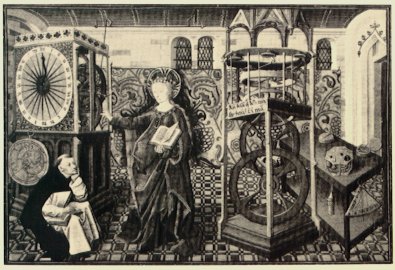Frére Jacques
Today, religious practice and the mechanical clock. The University of Houston's College of Engineering presents this series about the machines that make our civilization run, and the people whose ingenuity created them.
David Landes's book A Revolution in Time traces the measurement of time through time. Landes asks a double question: "What's driven us to measure time, and what's that measurement done to us?"
He thinks medieval monasteries set the stage: Regular prayer is an old idea. Ancient Jews prayed at daybreak, in the afternoon, and after dark. Islam called for daily prayers at dawn, just after noon, before and after sunset, and when it's dark again. (I'll never forget the eerie beauty of dawn in a remote Tunisian town. The call to prayer was sung from a minaret. Then overlapping calls spun from one minaret to the next, welling up and encircling us like a Bach canon. It left no doubt that the day had begun well.)
Early Christians mixed Jewish practice with Roman hours. St. Paul had ordained prayer without ceasing. If unceasing prayer was taken literally, no work would get done. The Church compromised by increasing the number of prayer events to eight. Those became the canonical hours with their old Roman names: Matins, Lauds, Prime, Terce, Sext, Nones, Vespers, and Compline.
Notice that only four of those times carry numerical names. That's because the Romans numbered only the daylight hours. Prime, the first hour, was the beginning of the measured day at 6:00 AM. Terce, the third hour, was 9:00 AM. You may wonder why the third hour was three hours after the first hour. That's because the Romans had no zero. Zero was an Indian invention that would be introduced by Arab scholars centuries later. Sext was noon and Nones was 3:00 PM. By the way, the old idea of rescuing someone at the "eleventh hour" meant 5:00 PM, or eleven hours after 6:00 AM.
The original Matins wasn't observed in the morning. Rather, it was a set of three awakenings or Nocturnes during the night, sometimes called Vigils. And here the fun begins: whoever tended the water clock through the night had the same kind of nervous responsibility as a military sentry. Monastic writings are filled with fretful fears of falling asleep during the night watch.
All this cried out for the invention of the mechanical clock. The sequence went like this: The canonical hours were well-defined by the ninth century. A century later, the Benedictines, then the Cistercians, made monasteries into a powerful part of medieval culture and economy. The Cistercians were consummate technologists.
Water clocks froze in winter and barely provided enough force to actuate bells. When weight-driven mechanical clocks appeared around 1300, they provided both the power and the accuracy that water clocks didn't have. Mechanical clocks solved the canonical hours problem, then went on to become both temporal and philosophical drivers in that once timeless life of contemplation. The canonical hours at last stopped serving as increments between prayers. Now they became the new boxes that would delineate all of modern life.
I'm John Lienhard, at the University of Houston, where we're interested in the way inventive minds work.
(Theme music)
Landes, D.S., Revolution in Time; Clocks and the Making of the Modern World. New York: Barnes and Noble books, 1983, Section I, Finding Time.
Frère Jacques, Frère Jacques,
Dormez-vous? dormez-vous?
Sonnez les matines, sonnez les matines,
Din, don, din; din, don, din.

L'Horloge de Sapience (the Clock of Wisdom) from about 1450.
The clock was, by now, becoming a metaphor for virtue of all kinds.